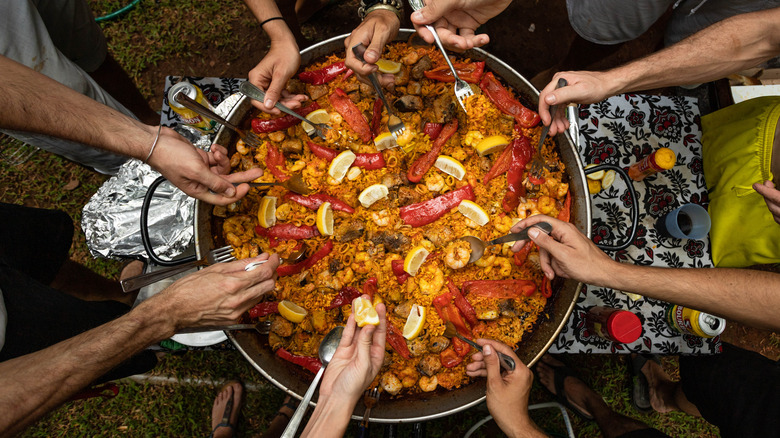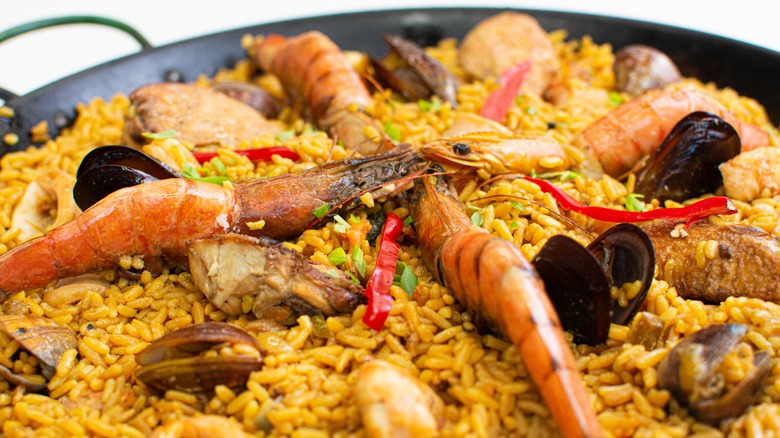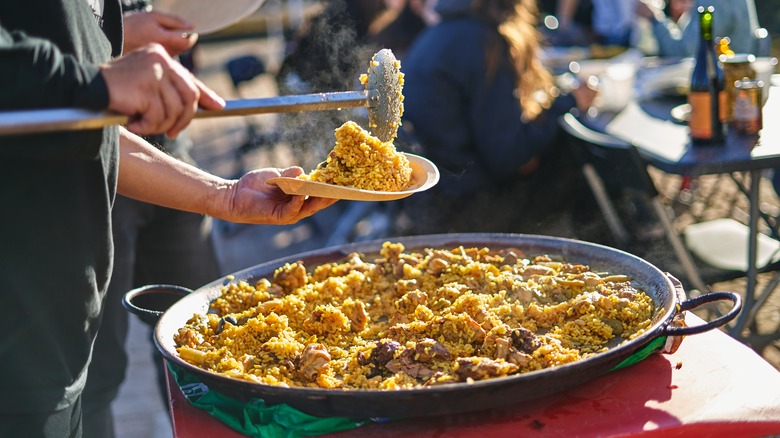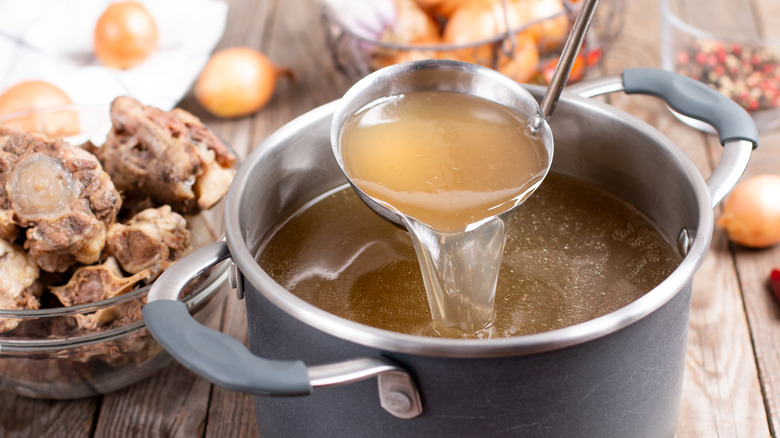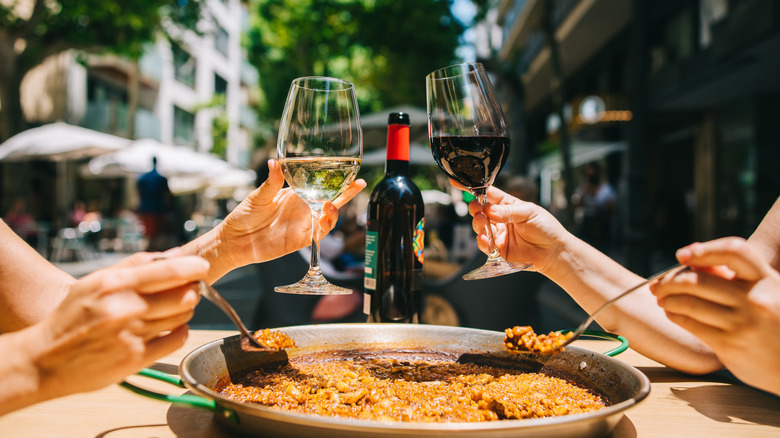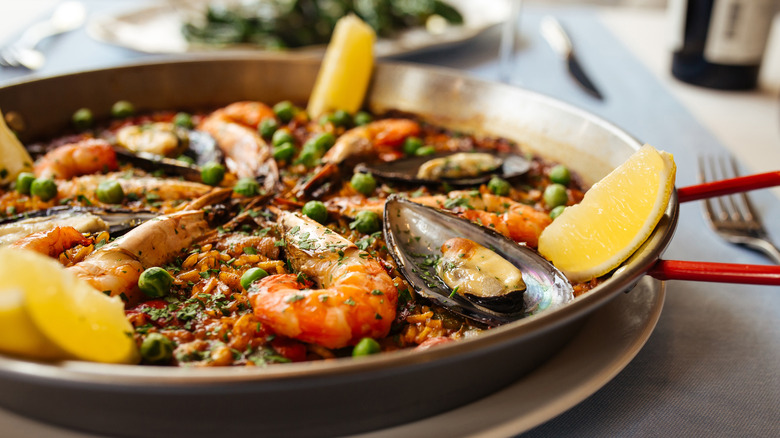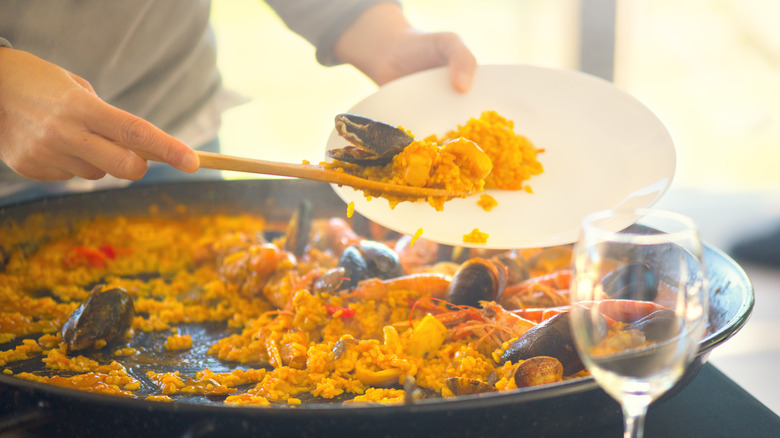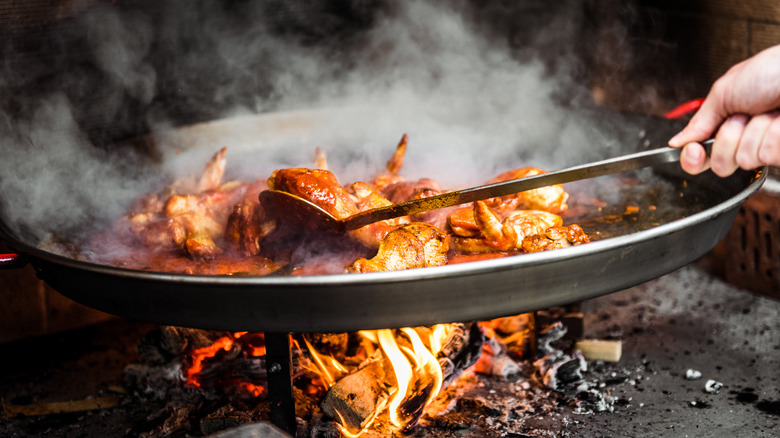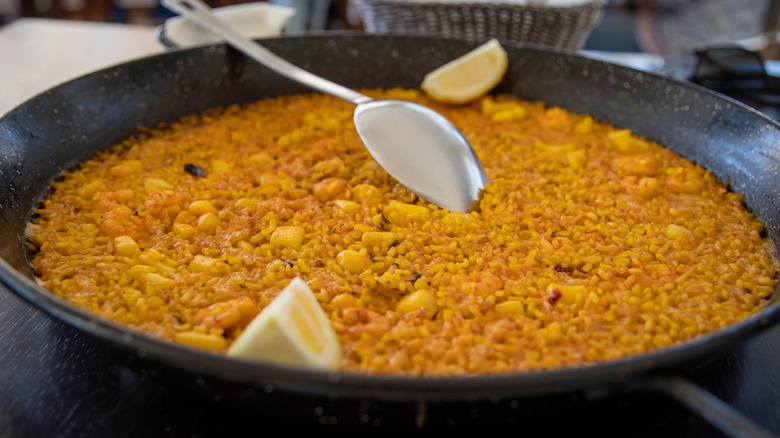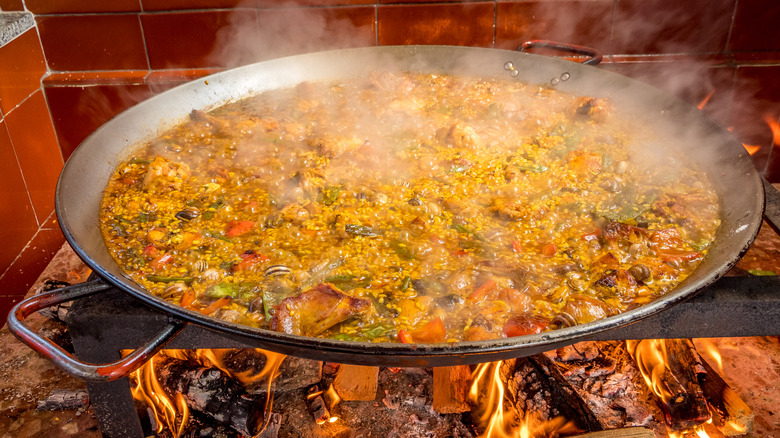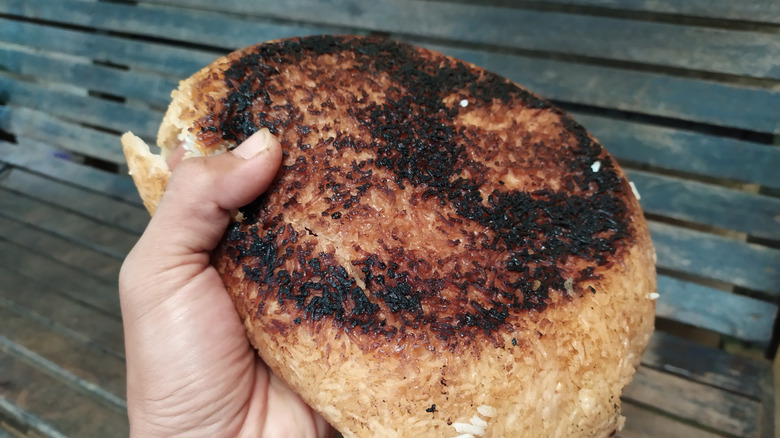11 Tips You Need For Cooking Paella
There's something simply magical about making a huge pan of paella up to serve at a dinner party, especially since this Spanish rice dish is one of only a few culinary creations that is as easy to make for a party of two as it is for a party of 20 or even 200. And so long as you have enough paella pans and ingredients to go around, the only limit to the number of people that can be fed off a pan of paella is, more likely than not, higher than the number of people you could possibly convince to come out and eat paella at your place.
But paella didn't earn its global popularity just by virtue of its ability to feed veritable armies worth of dinner party attendees. No, paella is so popular because, alongside its easy-to-adjust portioning potential, it is also a straightforward meal to make and so delicious that you may just catch your guests trying to sneak the pan, leftovers and all, into their car after dessert.
Making paella good enough to get your guests to consider committing a crime is ... well, criminally easy. All you need is some seafood, spice, and everything else that's oh-so-nice mixed with rice and served up hot. So, without making you wait any further, here are the 11 tips you need for cooking paella perfectly at home.
Follow a good recipe
If you want to make a great pan of paella, then it is absolutely essential that you start out the process first by finding a paella recipe that speaks to you. You don't have to follow it to the T, but even the least recipe-driven chefs out there should take a moment to study the ingredients and preparation behind making a professional pan of paella. This read-a-recipe rule is especially true if you have never made paella before and/or if there is an entire dinner party full of hungry people just waiting for their plates.
When choosing a paella recipe, make sure to first consider the source. And even if you completely trust the chef in question, don't be afraid to cross-reference their recipe against another one to make sure all the bases are thoroughly covered. For reference, it's worth knowing that a good paella recipe should include the following ingredients: rice, broth, saffron, paprika, sofrito, wine, various veggies, and protein (both surf and turf do nicely). For a truly traditional rendition of paella, look for recipes that include lima beans and rabbit. Alternatively, it is almost impossible to go wrong with a classic seafood paella recipe.
Use the right kind of rice
Anyone who has experience cooking with different kinds of rice knows that not all rice is created equal. And even if you were to take ten different types of rice and prepare them in the exact same way on the exact same day, the results would vary wildly from pan to pan.
So, when you're cooking up a pan of paella, what kind of rice do you want? Well, a perfect paella rice is, to explain it quite simply, a white rice that won't lose its shape during the cooking process. Instead of disintegrating into a gruel-like texture when cooked or sticking together so much that the paella is more akin to glue than anything approaching gourmet, paella rice should hold up to heat well enough to maintain the shape of each and every individual grain of rice.
The best paella rice is called Bomba. Bomba is a short-grain white rice with origins, you guessed it, in Spain. Bomba is the traditional type of rice used in paella as its textural integrity and ability to absorb flavor is excellent. And though Bomba rice really is the best, don't feel bad if you need to substitute it for a more accessible alternative. All you really need is a short-grain white rice that can hold its own over a slow simmer — risotto rice, also known as Arborio, is a common substitution that should work like a charm.
Balance all those seasonings
At its heart, paella is a simple dish with relatively few ingredients considering all of the fantastic aromatics and flavors having a full-out fiesta on your tastebuds with each and every bite. So, what's the trick to making a traditional Spanish paella with enough flavor to knock your socks off? Well ... like most things in life, the secret to making a perfectly prepared paella is all about balance — balancing seasonings, that is.
For those who are not aware of the spices that comprise the flavor profile that paella is famous for, it's as easy as saffron, paprika, and sofrito, which is a complex and savory spice blend made from a combination of aromatics such as dried onion, tomato, garlic, pepper, and so on. In utilizing these three spices (and a bay leaf if you're feeling fancy), you can make a paella so enchanting that even its aroma will have neighbors clambering over your garden gate for a plate of their own.
Saffron in particular is a notoriously tricky spice to get just right as it can easily over or underwhelm a dish, especially when paired with a complex spice blend such as sofrito. To avoid paella spice pandemonium, be sure to taste your seasoning blend before putting it into the dish so you can make adjustments ahead of time instead of in the heat of the moment.
Use homemade broth
Homemade broth is the secret to every exceptional recipe out there, and paella is, of course, no exception. For anyone still subscribing to buying boxes of premade stock, consider this your official (and final) notice to stop. Instead of spending way too much money on what is essentially overpriced, underwhelming water with only a whisper of the flavors that could have been, just make your own broth and be glad about it since having homemade broth on hand is better for the environment and saves you so much money, tastes so much better, and just so happens to be oh so easy to make.
So, the next time that you find yourself in possession of a few bones at the end of a meal, don't throw them away. Instead, either freeze the bones or immediately make them into a broth by adding a bit of celery, carrot, salt, pepper, and a bay leaf to a pot along with some water and letting it simmer for about three or four hours. After that, you've got a homemade broth that's better than anything you can buy from your local supermarket's stock ... and you will absolutely taste the difference in your paella.
Find a complimentary white wine
This tip for making perfect paella is one of the most important, and just so happens to be fun as well! After all, few things in life are more paella-appropriate than the age-old endeavor of cooking with wine. And when I say cooking with wine, I do mean both in the sense of cooking with wine as an ingredient as well as cooking with wine as an enjoyable pastime to keep those spirits high.
There is an art to pairing wine with food, one that could take years to truly master. But even those who have yet to delve into developing their inner sommelier can still select excellent cooking wine about 90 percent of the time. And since paella is a particularly forgiving dish when it comes to what wine goes into its preparation, it's almost easier to say what to avoid than what to look for.
In short, cooking with white wine is a safer bet for paella, especially if you're making a more delicately flavored seafood paella. That said, you could also get away with a less robust red wine as a perfectly acceptable addition to heartier paellas, such as the traditional rabbit paella recipe. What you want to avoid is sweet wines and wines with particular/particularly strong palettes that do not match your paella's flavor profile (i.e. wine with notes not suited to paella, like honeydew, green apple, or cloves, for example).
Source fresh meat or seafood
As stated earlier in this list of tips for making a perfect pan of paella, the trick that tips this Spanish rice dish from good to great is in the simplicity of its ingredients. And though having the right spices and rice is essential, so too is making sure that the protein you plan to put in your paella is fresh and of high quality. This is doubly true in the case of seafood paella since any fish you add to this dish will play a huge role in determining its final flavor.
So, if given the option, you should most certainly choose to have a bit less meat in your paella that is of a higher quality instead of settling for more meat of a lower quality. This will ensure that each and every bite of paella sings across your palate, delighting the tastebuds with the unmistakable flavor of perfectly fresh seafood, which is far better than a paella that's been packed to the brim with a whole lot of protein but not a lot of flavor.
If you are unsure about how to go about sourcing fresh meats and seafood, consider establishing a relationship with your local butcher and fishmonger or consider outsourcing to chef-approved online markets.
Less is more with paella ingredients
Paella is one of those dishes that can be made with practically anything you have, but that doesn't mean that you should throw the kitchen sink into it, thinking that more ingredients equals more flavor. The fact of the matter is that, like most meals, paella quickly reaches a point of diminishing return with the more is more mindset.
And while yes, you can absolutely add whatever it is that your heart desires to your personal paella pan — do so knowing that the appeal of paella is, surprisingly, in its simplicity. In fact, even putting onions in paella is controversial, so much so that many recipes rule it out due to its taste and textural effect. You see, though onions may seem like an obvious ingredient to add to just about any dish, there's something about their sweet taste that not only throws the overarching flavor profile of your paella off but also may very well make it more wet and mushy than most people would want to see piled on their plate.
So, be considerate and perhaps a bit choosy when selecting your paella flavor pairings. And remember, you can always add an ingredient or two next time you make paella, but you cannot take an ingredient or two away from a pot that's already been made (and possibly ruined).
Consider open-flame cooking
Cooking outdoors over an open fire is one of life's great pleasures — it also happens to be the traditional technique for making a mouthwatering pan of paella. And whether you're a seasoned culinary champ or a newcomer who isn't afraid to jump straight from the pan and into the fire, it is well worth the experience to at least try what it's like to watch as open flames lick at the base of your paella pan. Not only will this allow for an authentic approach to making paella, but it will also serve as entertainment for anyone attending your paella party.
Plus, there really is something to be said about the underrated qualities of smoke as a seasoning. And while there is nothing wrong with paella that's been made on a stovetop or in an oven, there really is something enchanting about the added element of fire and smoke. So, if you have the time, the means, and the ability to safely start and maintain a cooking fire, then you should seize the opportunity and cook your paella over a real, open flame ... especially if you have a kettle fire kit on hand.
Don't stir the pot
Unless you're an experienced paella professional who is looking to make an exciting fusion between risotto and paella, you had best be sure to leave those stirring spoons far and away from the paella pan ... at least until it's time to pile those dinner party plates high, of course. Otherwise, there is absolutely no reason that you should, in any way, be interacting with your paella between the point where you add the rice and the moment you're ready to serve and eat
The science behind stirring starches such as rice is a simple one. In short, the act of stirring (plus the movement and friction that comes with it) breaks down the starches that are present in ingredients such as potatoes, flour, and rice. This concept is best explained in the example of risotto, where the recipe calls for constant stirring in order to release the starches, thus making that gloriously thick sauce everyone knows and loves.
But if you were to stir your paella in the same way, then the same concept would apply and the individual granules of rice would break down and meld together until all that remains is a pot of paella porridge. And, in case it needs to be stated, it's better to have a crispy paella than a pan of what is essentially paella soup.
Don't put a lid on it
Rice is such a common culinary staple and is enjoyed in most cultures across the globe — but, despite it being an incredibly common ingredient, there are still a million and one mistakes that everyone makes with rice. And what is even more maddening than knowing how easy it is to mess up while making rice is knowing that what messes up one rice dish may very well be what makes another. In the same way that risotto breaks the rule of never stirring your rice, paella too requires a specific style of cooking that would ruin other rice recipes ... it asks that you leave everything entirely uncovered as it cooks.
Cooking a rice recipe without a lid may feel counterintuitive, especially considering how frequently we've been told to never (ever) lift the lid to check whether or not your rice is done. But, in the case of paella, it is imperative to keep any and all coverings far enough away to allow the steam to escape. This deviation from common rice rules is due to the ingredients inside of the paella, specifically the moisture they hold. If you were to put a lid on your paella pan, those liquids would add themselves to the broth and the wine and could very well turn the paella into a wet paste instead of a tasty plate.
Watch out for a burnt bottom
This tip for making paella should go without saying, but considering just how many culinary delights are lost each and every day to a burnt bottom, I feel compelled to caution chefs and home cooks alike. Nothing, and I mean nothing, will ruin an entire pan of otherwise perfectly prepared paella faster than burning the rice at the bottom of the pan. And if you're making paella over an open flame, this culinary crime is far easier to encounter than you may initially expect.
Some rice dishes aspire to have a bit of a crunch on the bottom, and paella can certainly benefit from a crispy granule here and there. But burning is something else entirely. And before you start asking, "But can't you just eat around the burnt bits?" know this — that acrid, awful flavor of burnt rice isn't something that stays conveniently located at the bottom of the pan. No, badly burnt rice is a flavor that permeates every inch of the pan it occupies. And, in the case of paella, every single bit of seafood, spice, wine, and rice that you worked meticulously to create will taste like literal ashes in your mouth should you let the bottom of the paella pan get hot enough to burn the bottom layer of rice.
